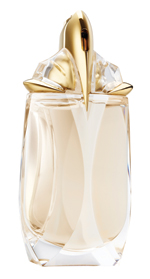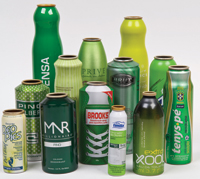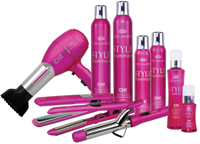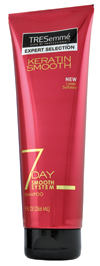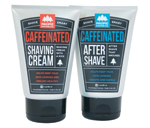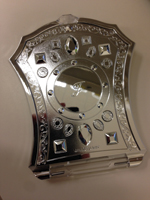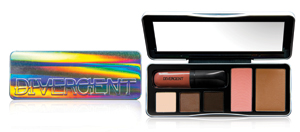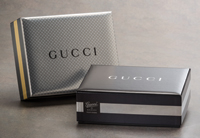
2014-05-26 07:22:11
Metal's Lustrous Look
2014-05-26 07:22:11
Metal, along with metallized effects, will make any package glisten—and attract attention. When there are numerous hair care styling products on store or salon shelves, for instance, the consumer’s eye will no doubt be drawn to the vibrancy of a reflective metallic cap or a glimmering metal can.
Both shiny and matte finishes are being used, in gold and silver, for all types of products from cosmetics to fragrance. Metal touches can convey “luxury” for a skincare product, inspiring the consumer’s trust in the formulation.
Conveying Luxury
No matter how they are used, metal, metallic effects, and even vacuum metallized plastic components are all traditionally synonymous with “luxury”– so they’re perfect when paired with a prestige fragrance.
The look of the new fragrance by Thierry Mugler, Alien Eau Extraordinaire (which is one of the many follow-up variations to the original Alien created in 2005), was even modeled after “a drop of gold,” and a “solar goddess.” The marquise-cut crystal gemstone shaped bottle has golden accents.
|
|
“Prestige brands have found that using metal is vital to creating unique and high-end packaging,” says Tim Thorpe, president, HCT Packaging.
There are several ways to achieve a high-end look, however, and many options are even accessible to mass brands—and are especially useful in conveying a “masstige” look.
Metallic features can even give a product an instant “upgrade” in the consumer’s mind, suppliers say. “Consumers associate a metallized look with brands that are typically more expensive, luxurious and chic. If a mass brand is able to achieve this, it will be more of a stand-out to the consumer,” says Wendi Caraballo, marketing manager, Essel Propack Americas.
Lou Della Pesca, president, 3C Inc., says that more of his prestige customers have been using metal over-shells and metallization techniques lately, for fragrance packaging as well as cosmetics—and lipstick, lipgloss, mascara and compacts are the ones most often requested.
“Sales of metallized cosmetic packaging components have been increasing due to their affordability, as well as the ability to be customized in any metallic color,” explains Della Pesca.
3C Inc. also offers cosmetic applicators, such as brushes, with metal ferrules and handles—for an upgraded look. “Choosing a brush with a full metal handle and ferrule can complement the look of a cosmetic line with metal or metallized components,” adds Della Pesca.
Whether a package is metal, or metallized, customized colors are an important option for a brand. (The team at Miss Universe even created a custom color for its metal cans; see details later in this article.)
“With the change of fashion trends also comes a change in the hues and tones of the metal packaging that we produce,” says Nick Gardner, executive vice president of sales, HCT Packaging. “One season we may predominantly use silver or chrome finishes, whereas the next season a rose gold may be more in demand,” he says.
Luxe Lipstick
Metal components have always been a classic choice for lipstick. Last spring, Lancôme first introduced its In Love collection that included the new Baume In Love, a tinted lip balm that’s moisturizing, with a dose of saturated translucent color.
This spring, a new set of limited edition lip balm colors has launched, in the same chic silver lipstick case as the one originally created for Lancôme’s lipstick, Rouge in Love. The package has a pretty decoration on the back of the cap that looks like a line of lace—reminiscent of a back seam on a thigh-high stocking.
For both Rouge and Baume in Love, Axilone created a metal cap that slides over a stamped aluminum tube, which is weighted. “The base of the tube is engraved with the brand name, and looks like a wedding ring,” says Virginie Lemeunier, vice president of sales & marketing, Axilone USA. “It is curved and rounded, an effect created by inflating and forming during the stamping process,” she explains. Lemeunier says the company specializes in stamping and shaping “complex aluminum parts.”
The front of the cap features the logo highlighted by a shiny background, and the rest of the cap has a matte finish. “The look was created using a double anodization process, and the logo is silk screened.
The fact that Axilone’s facilities are integrated with anodization lines makes it easier for a brand to take advantage of its double anodization capabilities, according to the supplier, and create designs that involve both matte and shiny finishes on one component.
Durable and Reusable
Metal is also ideal for creating reusable and refillable cosmetic packages—and brands are taking advantage of this feature.
Palettes with metal over-shells that are customizable and refillable are usually part of Urban Decay’s standard product lineup—and they are typically decorated differently each season to help convey the latest makeup trends. Last season, the brand created the palette, “Oz, The Great and Powerful,” with the help of HCT Packaging.
“This palette featured aluminum outers formed onto polypropylene. It is accompanied by pans, which are removable and metal lined for a more durable and luxe appearance,” explains HCT Packaging’s Gardner. “We have had a lot of success integrating metal over-shells onto palettes, which have become popular with our customers,” he adds.
HCT Packaging also produced a refillable aluminum mascara case for the eco-friendly cosmetic brand, Kjaer Weiss. The metal outer case is anodized aluminum, and its inner PP mascara package is sold separately as a refill—proving that luxury can be “green.”
“It was particularly challenging to design and develop the outer aluminum case that allows for the inner package to be easily removed, while maintaining good retention as the consumer uses the mascara,” explains Jackie Paterno, sales director, HCT.
Elevating the Aluminum Can
|
|
Aluminum cans have made the jump from deodorant to fragrance—changing their image in the process.
According to Matias Levit, vice president of sales & business development, Condensa, rigid metal cans are being chosen more often instead of traditional plastic bottles.
“Full aluminum bottles have become more attractive to beauty brands in recent years, due to the numerous benefits they can provide,” says Levit. “Since an aluminum bottle is crimped, this dramatically reduces the probability of leakage. Plus, it’s tamper-proof,” he adds.
Levit explains that using metal cans for fragrances was a popular trend among brands like Yankee Candle and Bath & Body Works many years ago—and now the look is back. Some companies, such as Crabtree & Evelyn, are choosing “hybrid bottles” for room spray fragrances, which are metal bottles combined with a plastic pump dispenser, instead of a traditional aerosol.
More brands may also be switching back to metal cans due to the advances in decorating options that are now available, which is critical in conveying a luxe look. “We’re one of the few companies in the world to still offer an aluminum can with a threaded neck, decorated using an offset printing process. It’s a niche type of package, but we will continue to manufacture it,” says Levit.
Mixing Materials, Matching Colors
Cans are also ideal for hair styling products—and metal can be decorated to perfectly match the finish on an aluminum hair styling tool. This is exactly what the folks at Miss Universe and Farouk Systems did for the Miss Universe Style Illuminate by CHI product line, which launched at Ulta stores on April 22.
In addition to matching the bold color of its metal cans with its hair dryer, curling iron and flat irons, a few plastic bottles in the line had to be color-matched as well.
The line consists of four hair styling products in metal cans, with a matte finish: Restage Dry Shampoo, Work Your Style Flexible Fold Hair Spray, Rock Your Crown Firm Hair Spray, and Spotlight Shine Spray. The caps are metallized plastic, with a mirrored finish.
Two products, Set the Stage Blow Dry Spray and Moringa & Macadamia Oil, are in translucent plastic bottles. Plus, there are four styling devices.
|
|
The team chose a Pantone color, Royal Plum, created especially for the Miss Universe Organization. The color—described by the organization as a “bold, striking and classic” choice—was created last year, with the help of brand image consultancy, Parham Santana. “This is our signature color, and we believe it is the best representation of our products and titleholders—and it’s vibrant, feminine and strong,” says Olivia Giudice, president & CFO, Miss Universe Organization.
When the styling tools, metal cans and plastic bottles are lined up on store shelves, they seem to match perfectly.
Giudice says the Miss Universe Organization spent a lot of time testing different cans, bottles, spray tops and colored materials to create a line that we were proud to put our name on—working closely with the team at Farouk. “We wanted to make sure the packaging was sleek, glamorous and vibrant, while still maintaining sophistication,” she says.
Celeste Figueroa, senior marketing manager, CHI and the Miss Universe licensing department, adds, “Tall sleek bottles and cans were chosen to represent the elegant appearance of the contestants. The silver metal caps and closures signify the winning crown.”
The bold color—and how it looks on metal—will certainly help the brand stand apart from competitors on store shelves.
Giving Tubes a High-End Twist & Shelf Appeal
|
|
Tubes are another popular option for hair styling brands—and just because a product is in a soft, squeezable tube doesn’t mean it can’t get the shine treatment as well. Plus, a metallized look can give a tube standout shelf appeal.
Essel Propack offers a new high-luster laminate called Egnite, which has the look of metal combined with the soft feel of a squeeze tube—and it offers functional features as well, such as excellent barrier properties.
“Our Egnite laminate provides a high-luster look, as well as “bounce back” characteristics—the tube maintains its shape when it is squeezed by the consumer,” explains Wendi Caraballo, marketing manager, Essel Propack Americas. “Unilever was one of our first customers to go commercial with our Egnite laminate, when the company re-launched its Tresemmé Keratin Smooth brand in January 2014,” she adds.
Shiny effects for tubes are becoming more popular, according to Carabello. “More beauty brands have been changing their decoration by adding effects like hot foil or high definition printing for a more high-end look—but the way we are able to give a tube a metallized luster has been rarely used, so it will get a brand noticed,” says Caraballo.
Tubes are also ideal for skincare products—and Cosmogen is offering new applicator options, designed to help increase a formulation’s efficacy.
|
|
A stainless steel roller applicator, attached to a round squeeze tube, gives Cosmogen Squeeze’N Flat Roller a clinical, professional look. “Using metal offers many hygienic advantages, without the chance of contaminating a product, and no possibility for a chemical reaction,” says Charlotte Clabaux, marketing manager, Cosmogen.
This tube was designed for anti-aging firming facial skincare products. The roller smooths and stretches the skin, to help break down fat cells using gentle pressure, which in turn helps to tighten facial contours, according to the supplier.
Another supplier offering tubes with metallic features is CTL Packaging USA. The supplier recently worked closely with Pacific Shaving on their newly launched Caffeinated Shaving Cream and After Shave.
|
|
“With the unique concept to ‘put caffeine on your mug, not in it,’ the brand wanted to differentiate on the shelf. We used a silver cold stamp, but muted the high shine with ink and a matte varnish to give it a more rugged, masculine appearance and feel,” explains Anna Soden, director of sales & business development, CTL Packaging USA.
The brand’s goal for the front of the plastic tube was to resemble a label, according to the supplier. “With our ‘easysupplytube’ process, we were able to achieve an entire 360 degree, seamless look—with the in-mold decoration,” Soden explains.
Dazzling with Deco
When decorating metal, an uneven surface will often pose a challenge—but suppliers such as The Penthouse Group offer solutions.
The Penthouse Group works with Yoshino in Japan, which developed a decorating technique that metallizes uneven surfaces. “The process is ideal for components with an irregular shape, where standard
|
|
metallization would usually lead to unwelcome metallization defects like pooling and orange skin,” explains Richard Esterbrook, sales manager, The Penthouse Group.
Yoshino’s technique prevents these common defects and allows brands to clearly differentiate themselves from their competitors. “Other suppliers will often tell a designer that certain surfaces can’t be metallized, especially if they’re not smooth.
|
|
We have the technical know-how to adjust the process and make it possible,” Esterbrook says.
The Penthouse Group is the U.S. sales office for Yoshino Kogyosho, the Japanese company that invented crystal metallization, which is its proprietary process. “Crystal metallization isn’t your standard metallized look—it’s unique, and will certainly differentiate a product,” says Esterbrook.
Crystal metallization features a repeating crystal pattern that is achieved in the metallization process itself, not through any secondary printing process. It’s a new, high-end custom decorating technique that is becoming popular in Japan, but has yet to be introduced with an actual product in the U.S. market. “Japanese brands have been pushing the envelope more on decorating, realizing the benefits of having a substantial packaging budget in order to make that possible,” Esterbrook explains.
HCT Packaging also creates innovative decorating techniques on metal. The supplier recently created metal palettes for Sephora’s Divergent brand, with a decoration that stands out.
“We used a foil over the metal tin, to create a holographic effect,” says Gardner. Some of the palettes also feature metal embellishments—a connecting clasp. “We utilized radial polishing in order to create a unique, light-reflective design,” he explains.
The Details Shine
Sometimes too many metallic features are overkill, for a designer creating a look for a beauty brand. Butdecorative metal components, including medallions, nameplates, coins and cap rings can add a touch of “luxe” at just the right dose.
International Metal Products (IMP) works with many masstige brands, developing decorative metal components, which are pre- or post-anodized. A medallion the company produced for Avon is glued to the top of its lipstick and nail polish packages.
This type of medallion is manufactured cost-effectively using high-speed progressive stamping. “Our process is done at 600 strokes per minute, with tight controls on product tolerances. Customers that have very short lead times, such as Avon, come to us because we are so efficient in pre-anodized aluminum stamping—and believe that no one can supply metal components faster,” says Yvonne Ostrowski, vice president, sales & marketing, IMP .
Ostrowski also believes that using metal for mass products is “virgin” territory—and key to upgrading a brand’s identity from mass to the coveted “masstige” status. “The skillful application of metal components to one’s packaging is the most challenging for the designers.Dare to think out of the box— you and your products will have that glitter that others don’t have,” she explains.
Metal can also be used to add a detail such as a faux necklace to a fragrance bottle—like Vera Wang did, in an effort to make sure her fragrance packaging complemented her jewelry line, which are both sold at Kohl’s.
The brand’s new flanker fragrance, Bejeweled Rouge by Vera Wang, launched by Coty, comes in a bottle that’s wrapped with a necklace, and metal was an essential component to achieve the look.
HCT Packaging used Zamac to create the jewel-encased collar, which resembles faux gemstones set in sterling silver. “The stones on the collar are meant to enhance the fragrance tint,” says Jackie Paterno, sales director, HCT Packaging.
Creating a Compelling Carton
When a beauty product, such as a fragrance, has a few shiny features, it makes sense to make sure the outer carton matches with just as much sparkle. Flashy, high-shine papers are often used for cartons, to create attention-grabbing looks.
Subtle details, such as foils and stamping, are used to add sparkle to a carton. The carton created for the fragrance Alien Eau Extraordinaire by Thierry Mugler glistens with a few subtle gilded gold accents, to complement the bottle’s gold features.
There are also ways to use metallic decorating techniques—minus the glitter and high-shine—for an elegant, understated look. Leo Papers offers a printing technique on its paperboard that resembles antique metal.
“Our innovation team at Leo Paper came up with a combination of four different processes to create a new look, which resembles antique metal—or by changing some of the inks, can make the effect look more modern,” says Bijan Pakzad, president of Leo Paper USA, which is a global printing and paper products manufacturer to the high-end gift and book market and now is breaking into beauty.
“We’re transforming our special finishing processes and applying our techniques to packaging for the beauty industry. Our product formats and processes are ideal for various types of packaging and have the ability to increase ‘value’ and attract the consumer at the point-of purchase,” Pakzad explains.
There’s no doubt that a metallic carton conveys “luxury”–but not if fingerprints are left behind every time a consumer touches the shiny box. Hazen Paper Company and McLean Packaging Corporation solved this issue for P&G, with the elegant set-up boxes created for Gucci’s Pour Homme and Made to Measure fragrances.?
Hazen laminated metallized film to 80-pound litho paper and applied “Ultracure” primer to deliver “layflat and stayflat” sheets that would feed smoothly through McLean’s high-speed UV offset press, evenly accepting inks as well as a final, fingerprint-resistant UV gloss coat.
Hazen recently won a technical award for these boxes at the 2014 AIMCAL Awards, presented by the Association of International Metallizers, Coaters and Laminators.
Another supplier, ITW Foils, offers “Eco-Shine” cold foils, which can be applied for a carton design that requires ‘heavy’ coverage, or fine details including halftones, according to Gary Jones, the company’s sales manager.
“We are seeing a big increase in cold foils being used as a nuanced and subtle enhancement. To reach more seasoned consumers, many brands are leaning toward subtle metallic glamour over shiny bling,” explains Jones.
Brands are also taking advantage of the efficiencies of cold-foils as on-press metallic treatment, which will increase the “elegance factor,” according to Jones.
“We also see more pairings of cold foils with post-press effects, such as spots of hot foil or gloss varnish and embossing—creating a contrast which lends a high-end sophistication,” says Jones, adding, “and as designers become aware of these possibilities, we look forward to seeing even more creative uses of metallics on outer packaging.”
Coming Down the Pipeline
Nearly all of the suppliers we spoke to say they expect to see requests for metal and metallized packages continue to increase.
Axilone has reinforced its industrial capacity this year, with the construction of a new factory in Spain. It is part of Axilone Metal, and specializes in metal stamping and anodization.
Condensa’s Levit says that as decorating processes for metal cans evolve, the package is likely to be in even more demand. “Digital offset printing for metal cans is a process that is still in the prototype stage, but it will offer many advantages for extruded cans, including shorter runs,” he explains.
Why hasn’t it been done before? “Offset printing can easily be done on a flat surface, but it’s a challenge to do on cylindrical bottle shapes. The printing process is meticulous, and requires an experienced supplier. Digitizing the process will give suppliers many more capabilities to achieve different looks,” says Levit.
He adds, “It’s the next stage of innovation for metal—and the industry can expect to see it soon.”
LinkedIn
